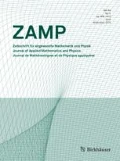Zusammenfassung
Vonneguts klassisches Experiment über das Zerstäuben kleinster positiv hoch geladener Wassertröpfchen aus einer Kapillare wurde in einem geschlossenen Gefäss unter kontrollierten Bedingungen wiederholt. Die Zerstäubungsversuche wurden bei verschiedenen Mischungsverhältnissen des die Kapillare umgebenden Stickstoff-Sauerstoff-Gemisches ausgeführt, wobei Nebelproben gesammelt und analysiert wurden. Die erhaltenen Resultate deuten auf eine mögliche Reaktion des an der Kapillarenspitze in der Corona aktivierten Stickstoffes mit Wasser. Dies führt zur Bildung von Nitrit- und Nitrationen im gesammelten Nebel. In Gegenwart kleiner Sauerstoffmengen wird das Nitrit quantitativ zu Nitrat oxydiert. Dieses für die Atmosphärenchemie möglicherweise bedeutsame Phänomen ist begleicet von einer anderen Erscheinung, die vielleicht in Beziehung steht mit der Bildung natürlicher Nebel. Es wird gezeigt, dass bei schrittweiser Senkung des Sauerstoff-Stickstoff-Druckes in der Umgebung der Kapillare die Flüssigkeit nicht mehr zerstäubt wird, sondern als Strahl auftritt. Der den Übergang kennzeichnende Druck hängt direkt von der Zusammensetzung des Gasgemisches ab. Im reinen Stickstoff findet unterhalb 760 torr bei den gewählten experimentellen Bedingungen kein Zerstäuben statt, wogegen in einer Atmosphäre, deren Zusammensetzung der Luft entspricht, der Übergang bei etwa 615 torr liegt, also bei einem Druck der 1700 m Meereshöhe entspricht.
References
B. Vonnegut andR. Neubauer,Production of Monodisperse Liquid Particles by Electrical Atomization, J. Coll. Sci.7 (1952), 616.
R. Neubauer andB. Vonnegut, Supplement toProduction of Monodisperse Liquid Particles by Electrical Atomization, J. Coll. Sci.8 (1953), 552.
V. Drozin,The Electrical Dispersion of Liquids as Aerosols, J. Coll. Sci.10 (1955), 158.
M. A. Nawab andS. G. Mason,The Preparation of Uniform Emulsions by Electrical Dispersion, J. Coll. Sci.13 (1958), 179.
W. N. English,Corona from a Water Drop, Phys. Rev.74 (1948), 179.
G. M. Schmid, R. M. Hurd andE. S. Snavely, Jr.,Effects of Electrostatic Fields on the Surface Tension of Salt Solutions, J. Electrochem. Soc.109 (1962), 852.
D. C. Blanchard:Electrically Charged Drops from Bubbles of Sea-water, and Their Meteorological Significance, J. Meteor.15 (1958), 383.
L. M. Branscomb,Photodetachment of Atmospheric Negative Ions, in:The Threshold of Space ed. M. Zelikoff (Pergamon Press, London and New York 1957), p. 101.
W. B. Kunkel andJ. W. Hansen,A Dust Electricity Analyzer, Rev. Sci. Instr.21 (1950), 308.
S. Twomey,The Electrification of Individual Cloud Droplets, Tellus8 (1956), 445.
L. G. Smith,Electric Charge of Raindrops, Q. J. Roy. Meteor. Soc.81 (1955), 23.
P. A. Allee andB. B. Phillips,Measurement of Cloud Droplet Charge, Electric Field and Polar Conductivities in Supercooled Clouds, J. Meteor.16 (1959), 405.
G. G. Goyer, J. E. McDonald, F. Bayer, andR. R. Braham Jr.,Effects of Electric Fields on Water-droplet Coalescence, J. Meteor.17 (1960), 442.
G. E. Charles andS. G. Mason,The Coalescence of Liquid Drops with Liquidliquid Interfaces, J. Coll. Sci.15 (1960), 235.
R. S. Allan andS. G. Mason,The Effects of Electric Fields on Coalescence in Liquid-liquid Systems, Trans. Far. Soc.57 (1961), 2027.
T. W. Zawidzki andH. M. Papée,Pseudo-whiskers of Ice Grown from Clouds of Supercooled Water in an Electric Field, Nature196 (1962), 568.
E. J. Bowen,The Chemical Aspects of Light (Clarendon Press, Oxford 1946), p. 212.
Author information
Authors and Affiliations
Rights and permissions
About this article
Cite this article
Zawidzki, T.W., Petriconi, G.L. & Papée, H.M. Vonnegut's spraying fountain—an oxygen-pressure dependent chemical process. Journal of Applied Mathematics and Physics (ZAMP) 14, 441–448 (1963). https://doi.org/10.1007/BF01601251
Received:
Issue Date:
DOI: https://doi.org/10.1007/BF01601251

